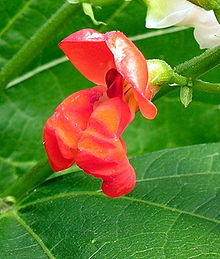| Phaseoleae | |
|---|---|
 | |
| Phaseolus coccineus | |
| Scientific classification | |
| Kingdom: | Plantae |
| Clade: | Tracheophytes |
| Clade: | Angiosperms |
| Clade: | Eudicots |
| Clade: | Rosids |
| Order: | Fabales |
| Family: | Fabaceae |
| Subfamily: | Faboideae |
| Tribe: | Phaseoleae Bronn ex DC. (1825) |
| Subtribes and genera | |
| See text | |
| Synonyms | |
| Phaseolinae Bronn (1822) Erythrineae (Benth.) Hassk. (1844) Glycineae Burnett (1835) | |
The plant tribe Phaseoleae is one of the subdivisions of the legume subfamily Faboideae, in the unranked NPAAA clade. This group includes many of the beans cultivated for human and animal food, most importantly from the genera Glycine, Phaseolus, and Vigna.
Although the tribe as defined in the late 20th century does not appear to be monophyletic, there does seem to be a monophyletic group which roughly corresponds to the tribe Phaseoleae (with some changes). The earlier concept of Phaseoleae is paraphyletic relative to the tribes Abreae and Psoraleeae, plus most of Millettieae and parts of Desmodieae.[1][2]
The following subtribes and genera are recognized by the USDA:[3]
- Cajaninae
- Adenodolichos Harms
- Bolusafra Kuntze
- Cajanus Adans.
- Carrissoa Baker f.
- Chrysoscias E. Mey.[Note 1]
- Dunbaria Wight & Arn.
- Eriosema (DC.) Desv.
- Flemingia Roxb. ex W. T. Aiton
- Paracalyx Ali
- Rhynchosia Lour.
- Clitoriinae
- Barbieria DC.
- Centrosema (DC.) Benth.
- Clitoria L.
- Clitoriopsis R. Wilczek
- Periandra Mart. ex Benth.
- Diocleinae
- Camptosema Hook. & Arn.
- Canavalia Adans.
- Cleobulia Mart. ex Benth.
- Collaea DC.
- Cratylia Mart. ex Benth.
- Cymbosema Benth.[Note 2]
- Dioclea Kunth
- Galactia P. Browne
- Lackeya Fortunato et al.[Note 3]
- Luzonia Elmer
- Macropsychanthus Harms ex K. Schum. & Lauterb.
- Neorudolphia Britton
- Rhodopis Urb.
- Glycininae
- Afroamphica H.Ohashi & K.Ohashi[4]
- Amphicarpaea Elliott ex Nutt.
- Calopogonium Desv.
- Cologania Kunth
- Dumasia DC.
- Eminia Taub.
- Glycine Willd.
- Haymondia A.N. Egan & B. Pan bis[5][6][7]
- Herpyza C. Wright
- Neocollettia Hemsl.
- Neonotonia J. A. Lackey
- Neorautanenia Schinz
- Neustanthus Benth.
- Nogra Merr.
- Pachyrhizus Rich. ex DC.
- Phylacium Benn.
- Pseudeminia Verdc.
- Pseudovigna (Harms) Verdc.
- Pueraria DC.
- Sinodolichos Verdc.
- Teramnus P. Browne
- Teyleria Backer
- Toxicopueraria A.N. Egan & B. Pan bis[5][6]
- Kennediinae
- Hardenbergia Benth.
- Kennedia Vent.
- Vandasina Rauschert
- Ophrestiinae
- Cruddasia Prain
- Ophrestia H. M. L. Forbes
- Pseudoeriosema Hauman
- Phaseolinae[8]
- Alistilus N. E. Br.
- Ancistrotropis A. Delgado
- Austrodolichos Verdc.
- Cochliasanthus Trew
- Condylostylis Piper
- Dipogon Liebm.
- Dolichopsis Hassl.
- Dolichos L.
- Helicotropis A. Delgado
- Lablab Adans.
- Leptospron (Benth.) A. Delgado
- Macroptilium (Benth.) Urb.
- Macrotyloma (Wight & Arn.) Verdc.
- Mysanthus G. P. Lewis & A. Delgado
- Nesphostylis Verdc.
- Oryxis A. Delgado & G. P. Lewis
- Oxyrhynchus Brandegee
- Phaseolus L.
- Physostigma Balf.
- Ramirezella Rose
- Sigmoidotropis (Piper) A. Delgado
- Spathionema Taub.
- Sphenostylis E. Mey.
- Strophostyles Elliott
- Vatovaea Chiov.
- Vigna Savi
- Wajira Thulin
- incertae sedis
- Apios Fabr.
- Butea Roxb. ex Willd.
- Cochlianthus Benth.
- Decorsea R. Vig.
- Diphyllarium Gagnep.
- Dysolobium (Benth.) Prain
- Erythrina L.
- Mastersia Benth.
- Meizotropis Voigt[Note 4]
- Mucuna Adans.
- Otoptera DC.
- Psophocarpus Neck. ex DC.
- Shuteria Wight & Arn.
- Spatholobus Hassk.
- Strongylodon Vogel
Notes
References
- ^ Wojciechowski MF, Lavin M, Sanderson MJ (2004). "A phylogeny of legumes (Leguminosae) based on analysis of the plastid matK gene resolves many well-supported subclades within the family". Am J Bot. 91 (11): 1846–1862. doi:10.3732/ajb.91.11.1846. PMID 21652332.
- ^ Li H, Wang W, Lin L, Zhu X, Li J, Zhu X, Chen Z (2013). "Diversification of the phaseoloid legumes: Effects of climate change, range expansion and habit shift". Frontiers in Plant Science. 4 (386): 1–8. doi:10.3389/fpls.2013.00386. PMC 3793175. PMID 24130564.
- ^ "Phaseoleae". Germplasm Resources Information Network. United States Department of Agriculture. January 17, 2003. Archived from the original on October 15, 2008. Retrieved August 6, 2010.
- ^ A Phylogenetic Study of Amphicarpaea with a New Genus Afroamphica
- ^ a b Egan AN, Pan B (2015). "Resolution of polyphyly in Pueraria (Leguminosae, Papilionoideae): The creation of two new genera, Haymondia and Toxicopueraria, the resurrection of Neustanthus, and a new combination in Teyleria". Phytotaxa. 218 (3): 201–226. doi:10.11646/phytotaxa.218.3.1.
- ^ a b Egan AN, Vatanparast M, Cagle W (2016). "Parsing polyphyletic Pueraria: Delimiting distinct evolutionary lineages through phylogeny" (PDF). Molecular Phylogenetics and Evolution. 104: 44–59. doi:10.1016/j.ympev.2016.08.001. hdl:10342/4191. PMID 27495827.
- ^ Egan AN, Puttock CF (2016). "The genus Haymondia A.N.Egan & B.Pan bis (Fabaceae) in Thailand". Thai Forest Bulletin (Botany). 44 (1): 26–31. doi:10.20531/tfb.2016.44.1.06.
- ^ Delgado-Salinas A, Thulin M, Pasquet R, Weeden N, Lavin M (2011). "Vigna (Leguminosae) sensu lato: the names and identities of the American segregate genera". Am J Bot. 98 (10): 1694–715. doi:10.3732/ajb.1100069. PMID 21980163.